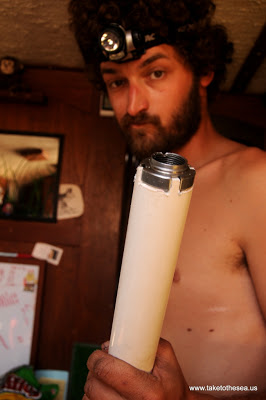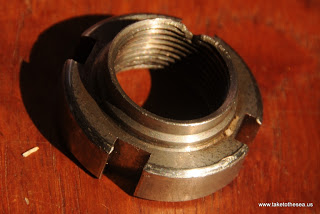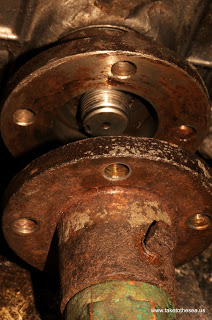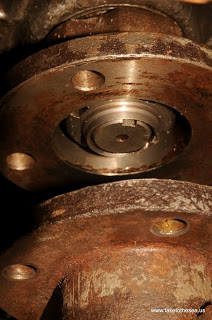 One of the first iterations of Jeff’s locknut tool
One of the first iterations of Jeff’s locknut tool
Jeff and I were en route to Los Islotes for
some quality time swimming with the seals. I’m actually somewhat terrified of
swimming with seals for totally irrational reasons, but I won’t always have prime
opportunities to face down my illogical fears. That’s an aside.
Within earshot of the barking seals, 0.5 miles to be
precise, Jeff and I both heard a kerplunk.
It’s almost like a comedy routine aboard our boat, except for the fact that it’s
not funny: 1) we look at each other simultaneously perplexed, worried and
pissed off, 2) Jeff bolts down the stairs into the cabin and tears them away (well,
more like awkwardly lifts and moves them out of the way) to reveal our engine,
3) Jeff squats and inspects the engine to see what might be amiss, 4) having detected
something amiss he yells at me to “kill it,” which I do, 5) my heart sinks a little.
The engine was vibrating more than usual and making an extra
humming sound. Thinking that maybe our prop had fouled Jeff donned his snorkel
gear and hopped in. Nothing. He spun the prop with his hands…it spun freely.
All good things. He then instructed me to turn the engine on again and try to
put it in forward and reverse. It wouldn’t click into gear and the prop didn’t
spin. He climbed back into the boat and started disassembling the quarterberth
and all of the panels surrounding the engine. There it was, the problem, no
question. The coupling that connects our transmission output shaft to the prop
shaft had wiggled itself loose of our transmission, meaning that our transmission
could no longer engage and spin our prop, meaning that we couldn’t get any
forward momentum via the motor.
So we did what any sailor would do in this situation, we
hoisted our sails and prayed for wind. The weather gods clearly took pity on us
and blessed us with a light breeze at our side. Ensenada Grande, a large
anchorage on the island was only a few miles away. The wind followed us,
nudging us gently, staying exactly on our portside even as we rounded the
corner and glided into the anchorage. Having deposited us safely in the bay,
the wind died just as we lowered our anchor into the water. Thank you, thank
you, thank you!
“I thought we were taking a vacation from boat work?” Jeff
stated, clearly disappointed by the events that unfolded.
When you travel with your home, on your home, the work
follows you. There really is no vacation even when you’re surrounded by turquoise waters, white sand beaches, all things vacation-y.
We pulled out all of the books we own on engine
installation, maintenance, and repair, along with our Yanmar 2QM15 manual and
spent the first couple of hours just trying to understand what we were working
with…how the transmission should operate under ideal conditions and how the
coupling normally remains attached to the output shaft.
The second (and most difficult) step was to disassemble the old,
slightly corroded coupling (familiar story?). There were four bolts connecting
the two couplings that clearly hadn’t been disassembled in a long time. Jeff
used all the tricks of the trade, spraying it down with PBlaster (this stuff is
ridiculously amazing), applying heat, using strategically applied force. No
movement. For most of the first day I heard him swearing in the cadence of a
clucking hen. It clearly wasn’t going well.
The boat was completely torn apart with things cluttering
every available surface. Tack and I shared the one available seat and continued
to mine the books for more information. Every once and awhile Jeff would call
out for a tool and I would retrieve and hand it to him like a surgeon’s
assistant. When he got tired of trying he would emerge with black and bloody hands
and let me have a go at loosening the pickle jar, so to speak. No luck. So we
decided to spray it with PBlaster again and wait.
Waiting is something we’re not always good at.
Since the cabin and cockpit were laden with the contents of
our quarterberth and “workshop” and our hearts were a bit heavy, we opted for a
dinner of dehydrated Mountain House meals. Purchasing Mountain House meals
before our departure was such a good investment. Just add hot water and you
have a comforting, delicious meal in minutes.
I’m happy to report that the waiting paid off. On day two I
sat and waited with anticipation, trying to decipher the grunts and groans
coming from the “engine room.”
 You can see the bite mark in the top right corner.
You can see the bite mark in the top right corner.
“Does that mean you got it?” I would ask with excitement,
like a child eagerly awaiting arrival at a destination.
“It budged at least!”
“Well, that’s something.” And something is better than nothing because it sheds light on what is possible. If you get one bolt off, you’re more likely to get all bolts off.
Racked by anticipation I undertook the extremely important
task of reorganizing Jeff’s DVD collection. There was so little space on the
boat I seriously couldn’t do much else. After an hour or so Jeff’s low voice
boomed from the quarterberth: “I am VICTORIOUS!” He emerged, the coupling
lock nut held high above his head. I did my own rendition of the victory dance
in the one square foot of open floor.
 The coupling without the nut.
The coupling without the nut.
So, it turns out that the coupling lock nut is supposed to
secure the coupling onto the output shaft. If engines don’t interest you,
please feel free to skip ahead, I won’t blame you. The output shaft coupling
has teeth on the inside that engage with the output shaft to put the prop in
forward or reverse motion. The spline on the output shaft looked fine, but the
teeth on the output shaft coupling looked worse for wear (at least that was
Jeff’s observation, which was further confirmed by books, experts and helpful people
on internet forums) and the lock nut was jiggling loose, therefore detaching the
coupling from the output shaft.
The locknut had a bite mark on one side that perplexed the
both of us. Had it been mangled somehow? The locknut needs to be threaded onto
the output shaft with a special tool (a tool that only costs about $300, no big
deal) and then you use a cold chisel to “caulk” or jam the locknut in place
(hence the bite mark). Well, suffice it to say that we didn’t have the special
tool and we didn’t have a cold chisel, so we improvised.
Jeff designed a whole suite of tools fashioned from PVC and
metal parts.
 The coupling with the nut.
The coupling with the nut.
“See, I told you this PVC would come in handy one day!” Jeff
collects and retains all sorts of little things and tools and the most random
things are always what we end up needing.
The tool evolved over time as Jeff learned what did and didn’t
work. It was an awkward, small space and you also need to get quite a bit of
torque on the nut. We cleaned all of the parts, reassembled the transmission to
the best of our ability with the available tools and replenished the oil in the
clutch case (since it had all oozed out). Success? We thought so. We at least
successfully diagnosed and surficially solved the problem (not realizing that
it was maybe bigger than originally anticipated). Time to clean the boat and resume our
vacation from boat work.
Was the transmission really fixed? Were our heroes able to get back
to La Paz? Stay tuned for the subsequent chapters in this gripping tale. Please forgive me if I tell this story out of order.